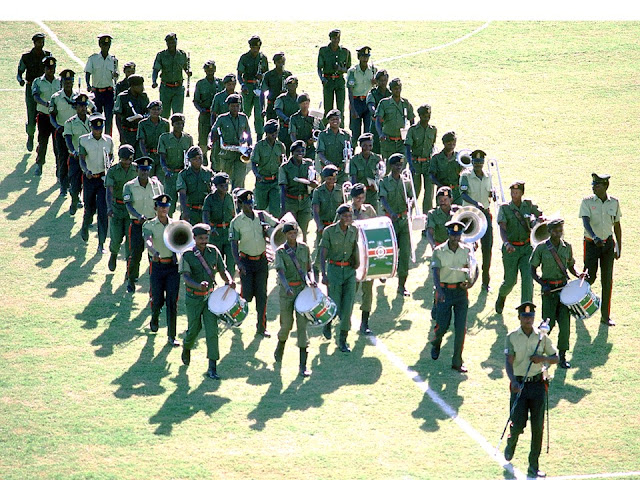Thursday, 31 July 1986: Conversations with a Sensitive Artist En Route to Jo’burg
The Trans-Karoo
Express left Cape Town promptly at 9:00AM for Johannesburg, and I bid adieu to
a city I’d learned to love in the space of four short days. It was another sunny day so I busied myself
with taking pictures as the train followed a circular route through the
vineyards of Paarl, Wellington, Tulbagh, Wolseley, and Worcester. As we climbed up the Hex River valley and
over the pass, I was eating lunch – a very small bowl of mushroom soup and
skimpy dessert which cost me R3.95. As
much as I like South African trains, their food sucks and is overpriced. I kept jumping from my dining car table to
run down to an open window for photos as new vistas appeared. The old Afrikaner steward seemed pleased that
I was so eager to photograph the spectacular countryside. He probably doesn’t meet many foreign travelers
with enthusiasm for South Africa landscapes these days.
View west from my train window of a vineyard and landscape
near Tulbagh, northeast of Cape Town.
View back in the direction of Cape Town as the Trans Karoo
Express slowly snakes its way up to the Hex River Pass.
Once over the pass, we were crossing the Karoo, an expansive dry plateau which supports little agriculture and is somewhat reminiscent of west Texas. I kept on shooting photos periodically until dusk arrived at Beaufort West.
My compartment mates were two relatively non-descript English-speaking white guys. However, at dinner that night I was seated with an interesting bearded chap around age 30. He was an artist named Jim who was on his way to Jo’burg to put on an exhibition of his work. The conversation got interesting, so we decided to buy some wine and take it back to his compartment.
The couple hours Jim
and I spent in his compartment was thoroughly enjoyable. The wine flowed freely and we smoked too many
cigarettes, but we touched on a number of artistic, political, social and
personal subjects. I learned, for
example, that black political art is often freely displayed in progressive, white
churches. Not only are churches somewhat
protected from the tentacles of the South African Police censors, but the arts
are as well. The government doesn’t take
the arts all that seriously as they figure it’s only of interest to a few
intellectuals who don’t have enough numerical strength to influence the
system. Unfortunately, they’re probably
correct.
The overnight Trans-Karoo Express from Cape Town to
Johannesburg covers about 900 miles (1500 km). Base map: Railway Map of South Africa and Neighbouring Territories, South African Railways, 1985.
As the train pulled into the DeAar station around 10:00PM – about 1½ hours late, I noticed a small black boy on the platform gesturing in our direction. “What do you suppose he wants?” I asked Jim.
“I know,” he replied while reaching into his duffle bag and pulling out a small container of Liquifruit orange juice. “Here you go,” Jim said to the kid after pushing down the window. The little boy walked up, took the orange juice from Jim, thanked him, and disappeared into the night. “He’s probably been waiting here a couple hours for this train. I couldn’t let him go away without some nourishment. I never give them money,” he added, “but I try to give them some good food if I have it.”
What a contrast with
the scene on the Johannesburg – East London train a couple weeks earlier when
laughing white school boys were throwing scraps of food, cigarettes and 1 cent
coins to little black urchins on a station platform in the Eastern Cape. There it resembled feeding time at the zoo;
here it was a simple act of kindness.
Too bad there are so many vicious white school boys in South Africa and
too few sensitive artists.
Comments in May 1987
while typing up my notes from 31 July 1986: One of the “mistakes” I made in my travels
through South Africa was to talk with too many of the “wrong” people – people
like Jim who were educated, intelligent, socially-conscious, and
anti-government, with a compassion for the plight of non-white South
Africans. I say this was a mistake
because these people are obviously not representative of the South African
white population as a whole as results of the May 1987 whites-only election
clearly demonstrate. True, I did talk to
average generic white South African racists and government apologists but found
them generally dull people. After
spending so much time travelling by myself in South Africa, I naturally
gravitated to people with whom I was on a similar wavelength. I needed stimulating friends, not shallow
conversation. This may not have been the
best journalistic approach, but seemed necessary for sanity maintenance.






Comments
Post a Comment